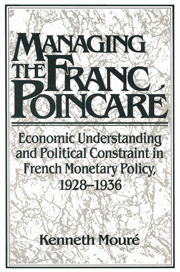 Managing the Franc Poincaré
Managing the Franc Poincaré Book contents
- Frontmatter
- Contents
- List of figures and tables
- Acknowledgments
- Abbreviations used in the notes
- Introduction
- 1 The depression in France
- 2 French gold accumulation, 1928–1932
- 3 The World Economic Conference and the gold bloc
- 4 The Bank of France: market control and interest-rate policy
- 5 The Treasury and government finance
- 6 The devaluation debate
- 7 Devaluation of the franc
- Conclusion
- Appendix
- Bibliography
- Index
4 - The Bank of France: market control and interest-rate policy
Published online by Cambridge University Press: 23 November 2009
- Frontmatter
- Contents
- List of figures and tables
- Acknowledgments
- Abbreviations used in the notes
- Introduction
- 1 The depression in France
- 2 French gold accumulation, 1928–1932
- 3 The World Economic Conference and the gold bloc
- 4 The Bank of France: market control and interest-rate policy
- 5 The Treasury and government finance
- 6 The devaluation debate
- 7 Devaluation of the franc
- Conclusion
- Appendix
- Bibliography
- Index
Summary
In normal circumstances with the franc on gold, the Bank of France was supposed to function as a reserve bank to concentrate the nation's gold reserves (monetary gold in circulation was less than 5% of French gold holdings) and to defend them with changes in its discount rate. A change in the Bank's discount rate in response to gold movements would contract or expand domestic credit as necessary to correct an external payments disequilibrium. The gold standard, however, was not as automatic as its apostles imagined and certainly had not worked in this way in France before 1914. The Bank of France kept its discount rate remarkably stable; between 1880 and 1913 it was raised only three times to defend against gold losses, and from 1900 to 1907 it remained unchanged at 3% for nearly seven years. Harry D. White concludes that during the thirty years before 1914, “in normal times the Bank of France exercised no influence on the contraction or expansion of credit”. Gold reserves were defended by charging a premium on gold delivered and redeeming notes with silver; this worked effectively against external gold losses without penalizing the domestic market.
In the interwar period the French economy saw few “normal” years. While the Bank remained responsible for defending the franc, the state was responsible for the national economy and, ultimately, for the currency. Relations between the state and the central bank had been strained in the 1920s by conflict over state borrowing from the Bank and the need for currency stabilization.
- Type
- Chapter
- Information
- Managing the Franc PoincaréEconomic Understanding and Political Constraint in French Monetary Policy, 1928–1936, pp. 120 - 155Publisher: Cambridge University PressPrint publication year: 1991


